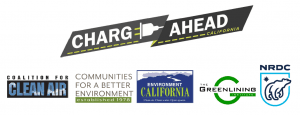Dear Senator Gonzalez and Assembly Member Reyes,
On behalf of the Charge Ahead California Campaign, led by the Coalition for Clean Air, Communities for a Better Environment, Environment California, The Greenlining Institute and the Natural Resources Defense Council, we urge the legislature to fully fund needed clean transportation programs and require those investments be made in historically disadvantaged and low-income communities. Low-income communities of color have borne the brunt of fossil fuel impacts over many decades, and should benefit from clean mobility and clean transportation options first and foremost. In additional to being the right choice ethically, bottom-up approaches and equity-based policies in the area of clean energy and clean transportation make economic and political sense and will allow California to reach its climate targets faster.
The Charge Ahead California Initiative established by SB 1275 (2014, de León) made it state policy to electrify the transportation sector in a manner that ensures all Californians, especially those who are most impacted by vehicular air pollution realize the benefits electric vehicles can provide. Largely as a result of that legislation, California has a rich portfolio of well-utilized equity-focused programs designed to increase access to zero-emission vehicles and mobility in disadvantaged and low-income communities. These include:
- Clean Cars 4 All: allows low- to moderate-income residents in the San Joaquin Valley, Sacramento, Bay Area, Orange County and Los Angeles regions to scrap old, clunker cars in exchange for vouchers for up to $9,500 for a new or used EV.
- Clean Vehicle Assistance Program: helps participants purchase clean vehicles using grants and low-interest rate loans.
- BlueLA: An innovative 100 percent electric car sharing service in LA available to anyone over 18 years of age with a valid driver’s license.
- Green Raiteros: This community-led program is built on an existing grassroots ridesharing network run by “raiteros,” (retired farmworkers). It provides Huron residents with access to two Chevy Bolts and one BMW i3 to travel to urban centers for medical service, shopping and other critical needs.
- Ag Worker Van Pool: Deploying 154 new 15-passenger hybrid vans to provide clean transportation to agricultural job sites in the Central Valley.
- Affordable Housing Mobility Hub: When launched, this program will provide nearly 3,000 low-income residents access to 24 electric vehicles plus chargers in Richmond and San Jose.
- Our Community Car Share: A free, membership-based transportation service in Sacramento that provides members with access to clean emission vehicles to run errands, get to appointments and take local trips.
- Lift Line Paratransit Dial-a-Ride: An electric vehicle transportation program that will provide clean mobility options to Santa Cruz County disabled residents via two 16-seat fully-electric shuttles equipped with wheelchair lift.
- Clean Mobility Options: A program that aims to support the retirement of high-polluting vehicles and to allow participants to go “car-free.”
- The Sustainable Transportation Equity Project (STEP): A pilot that aims to focus programs, capacity building, technical support, and education and outreach on target communities to result in transformative progress.
These light-duty vehicle programs are complemented by critical zero-emission medium- and heavy-duty vehicle programs that displace toxic diesel emissions; exposure to significant amounts of diesel exhaust can lead to premature death and other devastating health impacts including asthma and respiratory impacts, pregnancy complications and adverse reproductive outcomes, cardiac and vascular impairments, and heightened cancer risk. The combustion of fossil fuels by medium and heavy-duty vehicles also emits large quantities of NOx pollution, which contributes to the formation of both particulate matter pollution and ozone (i.e. smog). Finally, medium and heavy-duty vehicles emit GHGs that speed global climate change, which exacerbates local air quality issues through various means; climate-driven increases in ozone are predicted to cause premature deaths, hospital visits, lost school days, and acute respiratory symptoms, and wildfires made more frequent and more severe by climate change further increase emissions of particulate matter and ozone precursors and resulting in additional adverse local health outcomes. This “triple threat” disproportionately impacts low-income communities and communities of color that often live near freeways, ports, railyards, warehouses and other facilities that generate significant levels of localized diesel exhaust.
All of these efforts to speed the deployment of light, medium, and heavy-duty zero-emission vehicles and to increase access to those vehicles in disadvantaged and low-income communities require charging and fueling infrastructure. According to a legislatively-required California Energy Commission (CEC) report, the state will need over 1.5 million public and shared private chargers for light-duty vehicles and 157,000 fast chargers for medium and heavy-duty vehicles in 2030. The report finds that charging infrastructure deployment is lagging vehicle sales, and this gap may stymie progress toward the state’s public health, climate, and equity goals. 3
Accordingly, we recommend the legislature:
- Codify equity requirements to ensure:
- At least half of the CEC’s Clean Transportation Program budget be used to support transportation electrification for the primary benefit of or primarily serving residents of disadvantaged or low-income communities (e.g. increasing access to charging at single-family and multi-family homes in those communities);
- At least half of those projects and associated charging and refueling stations be located in disadvantaged or low-income communities;
- And no less than 30 percent of projects support zero-emission medium- and heavy-duty vehicles.
- Increase the governor’s request for $150 million for transportation equity projects to $200 million. The programs described above expand the benefits of clean mobility to all Californians and should be funded at a level that meets program demand. The legislature should also require the Enhanced Fleet Modernization Program focus on zero-emission vehicles.
- Approve the governor’s request $315 million for clean trucks, buses and off- road equipment. As noted above, tailpipe pollution produced by diesel medium and heavy-duty vehicles is particularly health-threatening. Communities of color are most burdened by this diesel pollution.
- Reauthorize the Clean Transportation Program and Air Quality Improvement Program (AB 118/AB 8), which provides incentives to support innovation and accelerate the development and deployment of advanced transportation technologies and fueling infrastructure. We support the securitization of $1 billion of these future revenues to support the expansion of the CEC’s Clean Transportation Program that include equity requirements.
Thank you for your consideration,
Coalition for Clean Air
Bahram Fazeli
Communities for a Better Environment
Laura Deehan
Environment California
Alvaro Sanchez
The Greenlining Institute
Max Baumhefner
Natural Resources Defense Council








